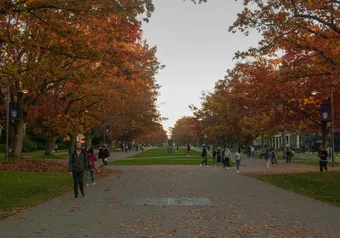A years-long trial against UBC and a refrigeration company for the alleged poisoning of a local creek is coming to an end.
Since 2016, UBC and CIMCO Refrigeration have been jointly charged with Federal Fisheries Act violations after allegedly dumping ammonia into a storm sewer on the Vancouver campus in 2014.
UBC was charged with four counts of Federal Fisheries Act violations: three regarding the deposit of deleterious substances and one for failure to notify the appropriate authorities.
Though CIMCO Refrigeration — a contracting company hired by the university and the co-accused — already pled guilty, the university is requesting acquittal on all four charges, placing the blame on their former partner.
According to a timeline of events established by UBC’s defence counsel, UBC’s head ice-maker at the Doug Mitchell Thunderbird Sports Centre, Jeff Harley, heard banging coming from key machinery at one of UBC’s ice rinks on September 12, 2014. When he couldn’t figure out the nature of the noise himself, he called an on-site CIMCO employee.
A conference call between three CIMCO employees soon led to an action plan, which eventually involved dumping ammonia product into an outdoor storm sewer.
According to investigators, that sewer feeds into Booming Ground Creek, a stream close to the Fraser River. They said that as a result of the chemical dumping, over 70 fish were killed over the course of three days. A sample taken of the water in the area soon after the incident identified ammonia levels over 300 times the lethal dose for fish.
During closing arguments, UBC sought to establish its relationship with CIMCO as one of trust and reliability, with the company as an “independent contractor at arm’s length from UBC.” They asserted that the technical difficulties associated with properly diluting ammonia for safe dumping is beyond anyone at UBC.
“Deference to CIMCO was well-entrenched,” said defence counsel Wally Braul, meaning that UBC would have reasonably trusted CIMCO to control the situation.
Crown counsels Charles Hough and Alex Clarkson argued that UBC did not only permit the deposit, but also actively participated in it, saying that the university was nowhere near establishing their due diligence.
Hough explained that UBC allowed the dumping to occur by directing CIMCO to the drain and witnessed the dumping without objecting to it. He said that he found it “remarkable” that UBC failed to train Harley about what should go down the storm drain and where it leads.
The Crown also pointed out that UBC failed to immediately report the event to authorities.
The dump was first reported at 4:30 p.m., when a professor noticed the smell while biking past and called UBC’s Environmental Services Facility (ESF). An ESF technician emailed UBC’s director of environmental services, Noga Levit, who emailed now-Chief Risk Officer Ron Holton. None of them called the authorities.
Another UBC staff member went with Levit to the arena at around 5:45 p.m. While the staff member did not report the strong ammonia smell because she thought Levit would, they told Harley and the CIMCO employee to stop dumping the solution.
A second professor noticed the smell at about 5 p.m. and called the RCMP 20 minutes after, leading the RCMP to contact an emergency program at 6:18 p.m.
In total, over five people were made aware of the issue and close to two hours went by before Emergency Management BC was called.
Hough argued that UBC should have called Emergency Management BC when the technician first met with the professor, or shortly after when higher-ups received emails from the technician.
Braul countered that the investigation itself was botched, saying that the timing and extent of the samples that investigators took are unreliable.
“Well, fish die,” he said, proposing that there could have been other contaminants from various other places upstream — between the storm drain and Brooking Creek — that flowed down and killed the fish. He called it a “large gap in the work done by investigators.”
The Crown countered that they did not need to prove if the quality of the water became deleterious after the substance was added, only that the substance added to the water was deleterious.
The judge pointed out that the burden of proving whether or not the deleterious substance came from another source was the responsibility of the defence, not the Crown.
“There’s a bunch of dead fish,” responded Judge Bonnie Craig.
In sum, the Crown Counsel said that there was a substantial gravity of harm and a reasonable expectation that UBC was in a position to prevent the act from occurring.
UBC said that since the incident, it has replaced its system with one that does not rely on ammonia. A university-wide environmental policy was put into place in summer 2014, just before the incident occurred.
A decision is set to be made at the Richmond provincial courthouse on November 27.
Share this article
First online





